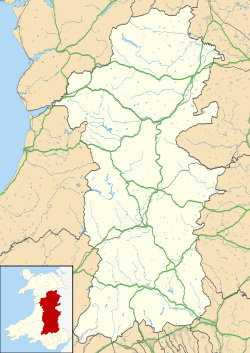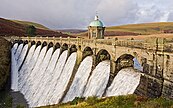Powys(/ˈpoʊɪs,ˈpaʊɪs/POH-iss,POW-iss,[4]Welsh:[ˈpou̯ɪs]) is acountyandpreserved countyinWales.[a]It bordersGwynedd,Denbighshire,andWrexhamto the north; the Englishceremonial countiesofShropshireandHerefordshireto the east;Monmouthshire,Blaenau Gwent,Merthyr Tydfil,Caerphilly,Rhondda Cynon Taf,andNeath Port Talbotto the south; andCarmarthenshireandCeredigionto the west. The largest settlement isNewtown,and the administrative centre isLlandrindod Wells.
Powys | |
|---|---|
| |
| Motto(s): | |
 Powys shown withinWales | |
| Coordinates:52°18′N3°25′W/ 52.300°N 3.417°W | |
| Sovereign state | United Kingdom |
| Country | Wales |
| Incorporated | 1 April 1974 |
| Unitary authority | 1 April 1996 |
| AdministrativeHQ | County Hall, Llandrindod Wells |
| Government | |
| • Type | Principal council |
| • Body | Powys County Council |
| •Control | No overall control |
| •MPs | 2 MPs |
| •MSs | 2 MSs |
| Area | |
• Total | 2,000 sq mi (5,181 km2) |
| • Rank | 1st |
| Population (2022)[2] | |
• Total | 133,891 |
| • Rank | 11th |
| • Density | 70/sq mi (26/km2) |
| Welsh language(2021) | |
| • Speakers | 16.4% |
| • Rank | 7th |
| Time zone | UTC+0(GMT) |
| • Summer (DST) | UTC+1(BST) |
| ISO 3166 code | GB-POW |
| GSS code | W06000023 |
| Website | www |
Powys is the largest and most sparsely populated county in Wales, having an area of 5,181 km2(2,000 sq mi) and a population of 133,891 in 2022.[2]AfterNewtown(11,362), the most populous settlements areYstradgynlais(8,270),Brecon(8,254), andLlandrindod Wells(5,602). The county is entirely rural, and characterised by multiple market towns and villages. TheWelsh languagecan be spoken by 16.4% of the population.[5]
The county is predominantly hilly and mountainous. To the west lie theCambrian Mountains,where theRiver SevernandRiver Wyeboth have their source on the Powys side of thePlynlimonmassif; together with their tributaries they drain most of the county. The southern quarter of the county is occupied by theBrecon Beacons(Bannau Brycheiniog) national park, and further north are two more upland areas,Mynydd EpyntandRadnor Forest.The only extensive area of flat land in Powys is the region northwest of Welshpool.
The county is named after theKingdom of Powys,which was a Welshsuccessor state,petty kingdomandprincipalitythat emerged during the Middle Ages following theend of Roman rule in Britain.Powys covers the same area as the historic counties ofMontgomeryshire,Radnorshire,andBrecknockshire.
Geography
editPowys covers the historic counties ofMontgomeryshireandRadnorshire,most ofBrecknockshire,and part ofhistoric Denbighshire.With an area of about 2,000 square miles (5,200 km2), it is now the largest administrative area in Wales by land and area (Dyfedwas until 1996 before severalformer countiescreated by theLocal Government Act 1972were abolished). It is bounded to the north byGwynedd,DenbighshireandWrexham County Borough;to the west byCeredigionandCarmarthenshire;to the east byShropshireandHerefordshire;and to the south byRhondda Cynon Taf,Merthyr Tydfil County Borough,Caerphilly County Borough,Blaenau Gwent,MonmouthshireandNeath Port Talbot.
The largest towns areNewtown,Ystradgynlais,Brecon,Welshpool,Llandrindod WellsandKnighton.Powys has the lowestpopulation densityof all the principal areas of Wales. Most of Powys is mountainous, and most roads and railways are relatively slow.
Just under a third of the residents have Welsh linguistic skills: Welsh speakers are concentrated mainly in the rural areas both in and aroundMachynlleth,LlanfyllinandLlanrhaeadr-ym-Mochnant(whereWilliam Morganfirst translated the whole Bible into Welsh in 1588) in Montgomeryshire, and the industrial area of Ystradgynlais in the southwest of Brecknockshire. In Radnorshire, the language survived into the 20th century west of Rhayader with a few native speakers from Nantmel parish surviving into the 20th century too. The2021 censusrecorded that 16.4% of the population were able to speak the Welsh language, a decline from 18.6% in2011and 21% in2001.[6][7]
History
editThe county is named after the ancient WelshKingdom of Powys,which in the sixth century AD included the northern two-thirds of the area as well as most of Shropshire and adjacent areas now in England, and came to an end when it was occupied byLlywelyn ap GruffuddofGwyneddduring the 1260s.
The uplands retain evidence of occupation from long before the Kingdom of Powys, and before the Romans, who built roads and forts across the area. There are 1130 identifiedburial moundswithin the county, of varying styles and ages, dating from 4000 BC to 1000 BC, most of them belonging to theBronze Age.[8]Of these, 339 arescheduled monuments.Standing stones,most again dating to the Bronze Age, also occur in large numbers, 276 being found across the county, of which 92 are scheduled. From theIron Age,the county has 90 scheduledhillfortsand a further 54 enclosures and settlement sites.
Powys is served by theCambrian LineandHeart of Wales linewhich offer connections to major towns and cities such asSwansea,Wrexham,Shrewsbury,Birmingham,Wolverhampton,Manchester,Cardiff,Aberystwyth,LondonandTelford.The county used to be served by key railways such as theMid-Wales Railway,Oswestry and Newtown Railway,Tanat Valley Light Railway,Llanfyllin Branch,Leominster and Kington Railway,Swansea Vale Railwayand theHereford, Hay and Brecon Railway,all of which offered connections toSouth Wales,Hereford,Oswestry,North WalesandWest Walesbut have all since closed.[citation needed]
Heraldry
editThe gold in the county coat of arms symbolises the wealth of the area. Black is for both mining and theBlack Mountains.Thefountainis amedievalheraldicchargedisplayed as aroundelbarry wavyargent and azure. It represents water and refers to both thewater catchmentarea and the rivers and lakes. Thus, the arms contain references to the hills and mountains, rivers and lakes, water supply and industry. The crest continues the colouring of the arms. A tower has been used in preference to amural crown,which alludes to the county's military history and remains. From the tower rises ared kite,a bird almost extinct elsewhere in Britain but thriving in Powys. The bird is a "seméof blacklozenges"for the former coal mining industry, while the golden fleece it carries is a reference to the importance of sheep rearing in the county.[9]
The county motto is:Powys – the paradise of Wales(Welsh:Powys Paradwys Cymru).
Government
editOn 1 April 1974, Powys was created under the Local Government Act 1972. At first, the former administrative counties ofMontgomery,Radnor,andBrecknockwere districts within it. On 1 April 1996, the districts were abolished, and Powys was reconstituted as aunitary authority.There was a minor border adjustment in the northeast—specifically, the addition of the communities ofLlansilinandLlangedwynfromGlyndŵrdistrict inClwyd—and with moving the border, so that rather than half of Llanrhaeadr-ym-Mochnant, all is included.
The firstLord Lieutenant of Powyswas previously theLord Lieutenant of Montgomeryshire.TheLord Lieutenant of BrecknockshireandLord Lieutenant of Radnorshirewere appointed as lieutenants. The presentlord lieutenantisShân Legge-BourkeofCrickhowell.
From 2024, Powys would be in the UK parliament constituencies ofBrecon, Radnor and Cwm TaweandMontgomeryshire and Glyndŵr,both of which extend out of the county.[10]
Attractions
edit- Black Mountains
- Brecon Beacons– a mountain range
- Radnor Forest
- Y Gaer– aRoman fort
- Battle of Bryn Glas
Castles
edit- Dolforwyn Castle
- Montgomery Castle
- Powis Castle
- Tretower Castle
- Aberedw Castle
- Castell Du
- Bronllys Castle
- Cefnllys Castle
Lakes, reservoirs and waterfalls
edit- Elan Valley Reservoirs
- Lake Vyrnwy
- Llangorse Lake
- Clywedog Reservoir
- Pistyll y Llyn– one of the highest waterfalls in Wales
- Pistyll Rhaeadr
- Water-breaks-its-neck – waterfall in Radnor Forest
- Waterfall Country– waterfalls on the upper tributaries of theRiver Neath
Cathedral
editCave systems
editMuseums and exhibitions
edit- Centre for Alternative Technology,Machynlleth
- Llandrindod Wells Museum
- National Cycle Museum,Llandrindod Wells
- Llanidloes Museum
- Knighton Museum,Knighton
- Museum of Welsh Textiles,Whitton, Powys
- Newtown Textile Museum
- Powysland Museum,Welshpool
- Judge's Lodging,Presteigne
- The Old Bell Museum,Montgomery
- Robert OwenMuseum,Newtown
- WHSmithMuseum, Newtown
- Rhayader Museum & Gallery, Rhayader
- Wyeside Arts Centre, Builth Wells
- Y Gaer,Brecon
- Llanwrtyd Wells Heritage and Arts Centre, Llanwrtyd Wells
Walks
edit- Glyndŵr's Way– a 135-mile (217 km) extended loop through Powys between Knighton and Welshpool
- Sarn Sabrina Walk – a 25-mile (40 km) circular walking route fromLlanidloesto the source of theRiver Severn[11]
- Severn Way– described by the Long Distance Walkers Association as a 224-mile (360 km) waymarkedlong-distance trail[12]
- Taff Trail– walking and cycle path that runs for 55 miles (89 km) between Cardiff Bay and Brecon
- Offa's Dyke Path– a long-distance footpath about 177-mile (285 km)
- Wye Valley Walk– a 136 miles (219 km) long-distance footpath fromChepstowtoRhayader
Railways
edit- Brecon Mountain Railway(heritage line)
- Cambrian Line(main line)
- Heart of Wales line(main line)
- Welshpool & Llanfair Light Railway(heritage line)
Fairtrade
editIn December 2007, Powys was awardedFair Trade Countystatus byThe Fairtrade Foundation.[13]
See also
editNotes
edit- ^Located in the east-central parts of Wales, either in theMid WalesandEast Walesregions or in bothNorthandSouth Walesunder historical definitions.
References
edit- ^"Council Information".Powys County Council.Retrieved6 August2024.
- ^abc"Mid-Year Population Estimates, UK, June 2022".Office for National Statistics.26 March 2024.Retrieved3 May2024.
- ^"How life has changed in Powys: Census 2021".Office for National Statistics.19 January 2023.Retrieved6 August2024.
- ^"Powys".Collins English Dictionary.HarperCollins.Retrieved6 August2023.
- ^"How life has changed in Powys: Census 2021".
- ^"How life has changed in Powys: Census 2021".Retrieved3 June2023.
- ^Welsh Language Board,(disbanded 2012),Archived version of the statistics page, 30 March 2012
- ^Clwyd-Powys Archaeological Trust: Introducing Prehistoric burial and ritual sites.Archived2016-03-04 at theWayback MachineAccessed 6 April 2014
- ^"Powys".Heraldry of the world.(Outdated file.)
- ^"2023 Parliamentary Review - Revised Proposals | Boundary Commission for Wales".Boundary Commission for Wales.Retrieved20 June2023.
- ^"Cambrian Mountain Events Home Welcome to the Sabrina Walk".llanidloes.Retrieved20 August2021.
- ^"Severn Way".Long Distance Walkers Association.Retrieved21 March2010.
- ^Sally Williams."FairTrade Resource Network".Archived fromthe originalon 4 October 2011.Retrieved3 July2008.



